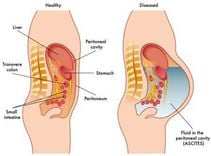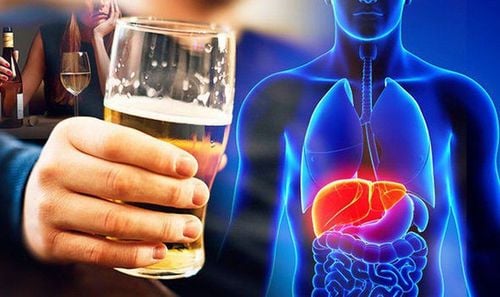This is an automatically translated article.
The article is professionally consulted by Master, Specialist II Phan Thi Minh Huong - Gastroenterologist - Department of Medical Examination & Internal Medicine - Vinmec Danang International General HospitalFatty liver is a condition in which the accumulation of fat in the liver affects the function of liver cells. Fatty liver, if left untreated, can lead to cirrhosis and liver cancer. Based on the cause, fatty liver can be divided into two main groups: alcoholic fatty liver and non-alcoholic fatty liver.
1. What is fatty liver?
Fatty liver is a condition in which fat is stored in the liver. Criteria for diagnosis of fatty liver are based on evidence of liver biopsy when fat cells are larger than 5% of liver cells on histology or on imaging criteria through imaging means.Fatty liver can be diagnosed based on abdominal ultrasound. This technique has many advantages such as low cost, can evaluate more information about hepatobiliary. This is considered as the primary means of diagnosis of fatty liver. In addition, magnetic resonance imaging or computed tomography is also of high value in the diagnosis of fatty liver. Another imaging technique is the controlled attenuation parameter (CAP) to help determine the degree of fatty liver. Diagnosis can also be based on fatty liver indicators such as FLI (Fatty liver index), SteatoTest and NAFLD liver fat score.
In the early stages, fatty liver can be considered a benign disease, which can go away on its own if you change your lifestyle and have a reasonable lifestyle. However, if this accumulation of fat goes on for a long time, it can damage liver cells, form liver fibrosis and develop into cirrhosis, liver cancer.

Siêu âm bụng giúp chẩn đoán tình trạng gan nhiễm mỡ
2. Alcoholic fatty liver and non-alcoholic fatty liver
Fatty liver can be divided into two main groups: primary fatty liver and secondary fatty liver. In the secondary group, the leading cause is alcohol, followed by causes of viruses B, C, Wilson's disease, and drugs. Because of the high percentage of alcohol, fatty liver is often divided into two main groups: non-alcoholic fatty liver (primary) and alcoholic fatty liver (secondary).The direct cause of alcoholic fatty liver is the heavy use of alcoholic beverages. Heavy drinking was defined as drinking more than 210 grams of alcohol per week over 2 years in men and more than 140 grams of alcohol per week over 2 years in women. To diagnose alcoholic fatty liver disease, the patient must meet the criteria for fatty liver and must have a history of heavy alcohol use as mentioned above.
Similarly, nonalcoholic fatty liver disease is diagnosed when the criteria for fatty liver are met but there are no secondary causes of fatty liver such as alcohol consumption, hepatitis B and C, Wilson's disease, fat intake, malnutrition, drugs, acute fatty liver in pregnant women and congenital metabolic defects.

Gan nhiễm mỡ nguyên phát do các nguyên nhân khác ngoài rượu gây ra
3. Distinguish between alcoholic fatty liver and non-alcoholic fatty liver
3.1. Risk factors For alcohol-related causes, the direct risk factor for fatty liver disease is excessive alcohol use. In addition to the alcohol use criteria mentioned above, the diagnosis can be made with regular alcohol consumption of more than 20g/day in women and more than 30g/day in men.
The cause of nonalcoholic fatty liver is unclear. The associated risk factors such as obesity, type 2 diabetes, metabolic syndrome, polycystic ovary syndrome, sleep apnea syndrome, hypothyroidism, hypopituitarism. In particular, obesity is the main risk factor for nonalcoholic fatty liver disease. Fat metabolism disorders with hypertriglyceridemia and decreased HDL cholesterol are also common.
3.2. Clinical symptoms Regarding clinical symptoms in the early stages, there is almost no difference in symptoms between these two conditions. The major distinguishing factor is the history of alcohol use and the exclusion of other causes of secondary fatty liver.
For patients with alcohol causes, there are often markers of heavy alcohol use such as AST/ALT ratio greater than 2, elevated GGT. In addition, there are episodes of acute alcoholic hepatitis, prolonged QT interval, hypoalbuminemia, thrombocytopenia in severe cases. Severe alcoholics may develop withdrawal symptoms during treatment, progressing to cirrhosis and early liver cancer.
Nonalcoholic fatty liver usually has fewer symptoms, liver enzymes may be elevated, but without elevated liver enzymes, nonalcoholic fatty liver disease cannot be ruled out. For these patients, tests for viral markers such as HBsAg, anti-HBs, anti-HBc, anti-HCV should be indicated, quantification of Fe, ferritin, serum Gammaglobulin, ANA, SMA or LKM1.

Gan nhiễm mỡ không do rượu cần xét nghiệm để tìm dấu ấn của virus
3.3. Treatment of fatty liver With alcoholic causes, recommending patients to quit drinking is the most necessary treatment step. Patients can follow a scientifically reduced alcohol consumption regimen under the guidance and advice of a doctor. Besides, it is possible to use drugs to help patients with alcohol withdrawal such as Baclofen, Acamprosate, Naltrexone.
Treatment of non-alcoholic fatty liver is the treatment of risk factors, lifestyle changes, and possibly a combination of drugs. Patients with non-alcoholic fatty liver disease who are obese should lose weight, control blood sugar well if they have diabetes, control blood pressure, and correct dyslipidemia if present. Lifestyle changes: reduce calorie intake each day, increase physical activity and have a reasonable diet.
In addition, the treatment of nonalcoholic fatty liver can be combined with drugs such as vitamin E supplements or using PPAR-gamma agonists depending on the doctor's prescription.
Please dial HOTLINE for more information or register for an appointment HERE. Download MyVinmec app to make appointments faster and to manage your bookings easily.













